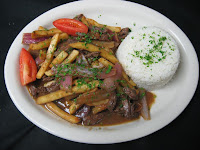- Ceviche- If peru had an official national dish, it would be this preparation of raw fish marinated in citrus juice. The acid in the fruit ( lemon) cooks the fish, giving it a delicate falvor. The dish is usually spiced with red onions and aji pepper and served with potato or corn.
- Cuy- No way to sugarcoat it. This staple meat reaised in household of the Andes is the guinea pig. The meat, which is quite bony, is usually baked or barbecued on a pit and served whole.
- Causa- Because of Peru's variety of potatoes and shocking amounts of avocado; the Causa is a casserole with both of these ingredients. It is served cold and has layers of tuna, meat or hard-boiled egg.

- Lomo Saltado- This dish, invented by the Chinese, who arrived to Peru looking for work, includes beef, tomatoes, onions, peppers, blended in a pan with soy sauce and fried potatoes. It is also served with rice.

- Aji de Gallina- Velvety stew made with chicken, condensed milk and thickened with decrusted bread. Served with rice, boiled egg, and an olive.
- Anticucho- This marinated meat is served everywhere in Peru. Highe-end restaurants offer it as appetizers, as well as street-cart vendors. While almost any meat can be prepared this way, the most traditional and best anticuchos are made with beef's heart. This is because it is believed Spanish conquerors would consume a cow's choicest cut and leave the organs for their slaves.
- Rocoto Relleno- This dish is typically associated with Arequipa, Peru’s second largest city, but it is served everywhere. What appears to be a plain-old red bell pepper is actually a fiery Capsicum which is at least ten times as hot as a jalapeño when raw, but boiled to reduce its thermonuclear properties, stuffed with spiced, ground beef and hard-boiled egg. This is topped with melted white cheese, baked, and served whole.
- Pollo a la Brasa- This Peruvian-style roast chicken is DELICIOUS AND POPULAR and it’s now available in cities around the globe. The secret is marinating the bird in soy sauce flavored with red peppers, garlic, and cumin, which gives the meat and skin a smoky, salty taste. Outside Peru it’s typically paired with French fries.
- Lucuma- Lucuma is a tree fruit that looks like a mango, but it has a custardy taste akin to maple syrup. It’s usually used as a flavoring in desserts, and is justifiably popular as an ice cream aswell.
- Mazamorra morada- This is a popular Peruvian dessert made from purple corn. It's thickened into a pudding like texture with potato flour or corn starch, and spiced with cinnamon. It tastes like blackberry but more exotic. Mazamorra has a deep purple colour and it is usually served cold.
















